Mathematics Homework: Calculus, Vectors, Sets, and Function Analysis
VerifiedAdded on 2023/06/08
|7
|1614
|101
Homework Assignment
AI Summary
This homework assignment presents solutions to a series of mathematical problems. Question 1 explores set operations, including intersections, unions, and the concept of the empty set, along with a number line representation. Question 2 investigates the properties of functions, differentiating between functions and non-functions based on their mapping characteristics. Question 3 delves into calculus, focusing on limit calculations, including indeterminate forms and the application of L'Hopital's rule. Question 4 explores vector operations, calculating unit vectors, angles between vectors using the dot product, and linear combinations. Question 5 examines set theory, including intersections, unions, and the concept of the empty set. Finally, Question 6 addresses function properties such as continuity, asymptotes, and piecewise functions.
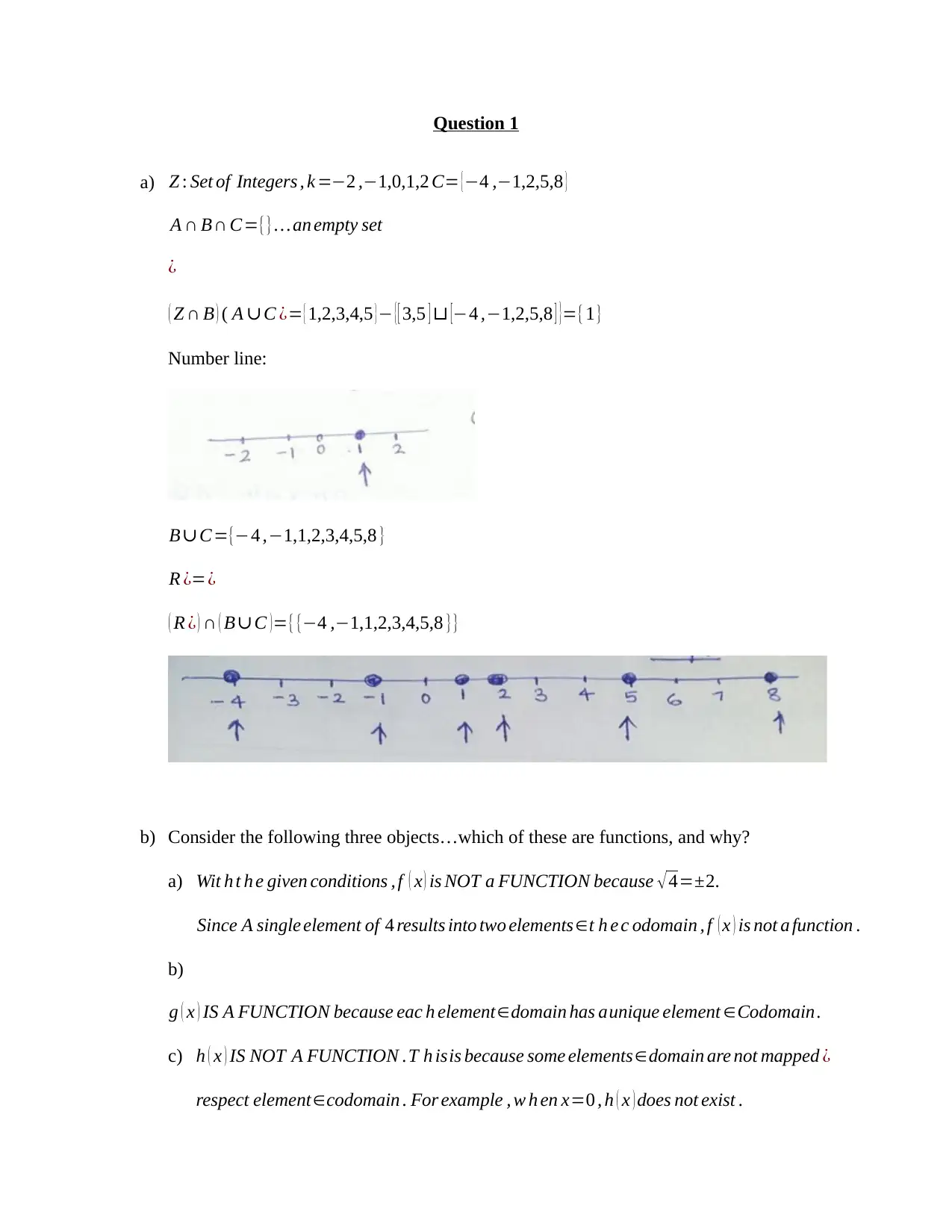
Question 1
a) Z : Set of Integers , k =−2 ,−1,0,1,2 C= {−4 ,−1,2,5,8 }
A ∩ B∩ C={}… an empty set
¿
( Z ∩ B ) ( A ∪C ¿= { 1,2,3,4,5 }− {[ 3,5 ] ⊔ [−4 ,−1,2,5,8 ] }={1}
Number line:
B∪C={−4 ,−1,1,2,3,4,5,8 }
R ¿=¿
( R ¿ ) ∩ ( B∪C ) ={{−4 ,−1,1,2,3,4,5,8 }}
b) Consider the following three objects…which of these are functions, and why?
a) Wit h t h e given conditions , f ( x ) is NOT a FUNCTION because √ 4=±2.
Since A single element of 4 results into two elements∈t h e c odomain , f ( x ) is not a function .
b)
g ( x ) IS A FUNCTION because eac h element∈domain has aunique element ∈Codomain.
c) h ( x ) IS NOT A FUNCTION .T h isis because some elements∈domain are not mapped ¿
respect element∈codomain . For example , w h en x=0 , h ( x ) does not exist .
a) Z : Set of Integers , k =−2 ,−1,0,1,2 C= {−4 ,−1,2,5,8 }
A ∩ B∩ C={}… an empty set
¿
( Z ∩ B ) ( A ∪C ¿= { 1,2,3,4,5 }− {[ 3,5 ] ⊔ [−4 ,−1,2,5,8 ] }={1}
Number line:
B∪C={−4 ,−1,1,2,3,4,5,8 }
R ¿=¿
( R ¿ ) ∩ ( B∪C ) ={{−4 ,−1,1,2,3,4,5,8 }}
b) Consider the following three objects…which of these are functions, and why?
a) Wit h t h e given conditions , f ( x ) is NOT a FUNCTION because √ 4=±2.
Since A single element of 4 results into two elements∈t h e c odomain , f ( x ) is not a function .
b)
g ( x ) IS A FUNCTION because eac h element∈domain has aunique element ∈Codomain.
c) h ( x ) IS NOT A FUNCTION .T h isis because some elements∈domain are not mapped ¿
respect element∈codomain . For example , w h en x=0 , h ( x ) does not exist .
Paraphrase This Document
Need a fresh take? Get an instant paraphrase of this document with our AI Paraphraser
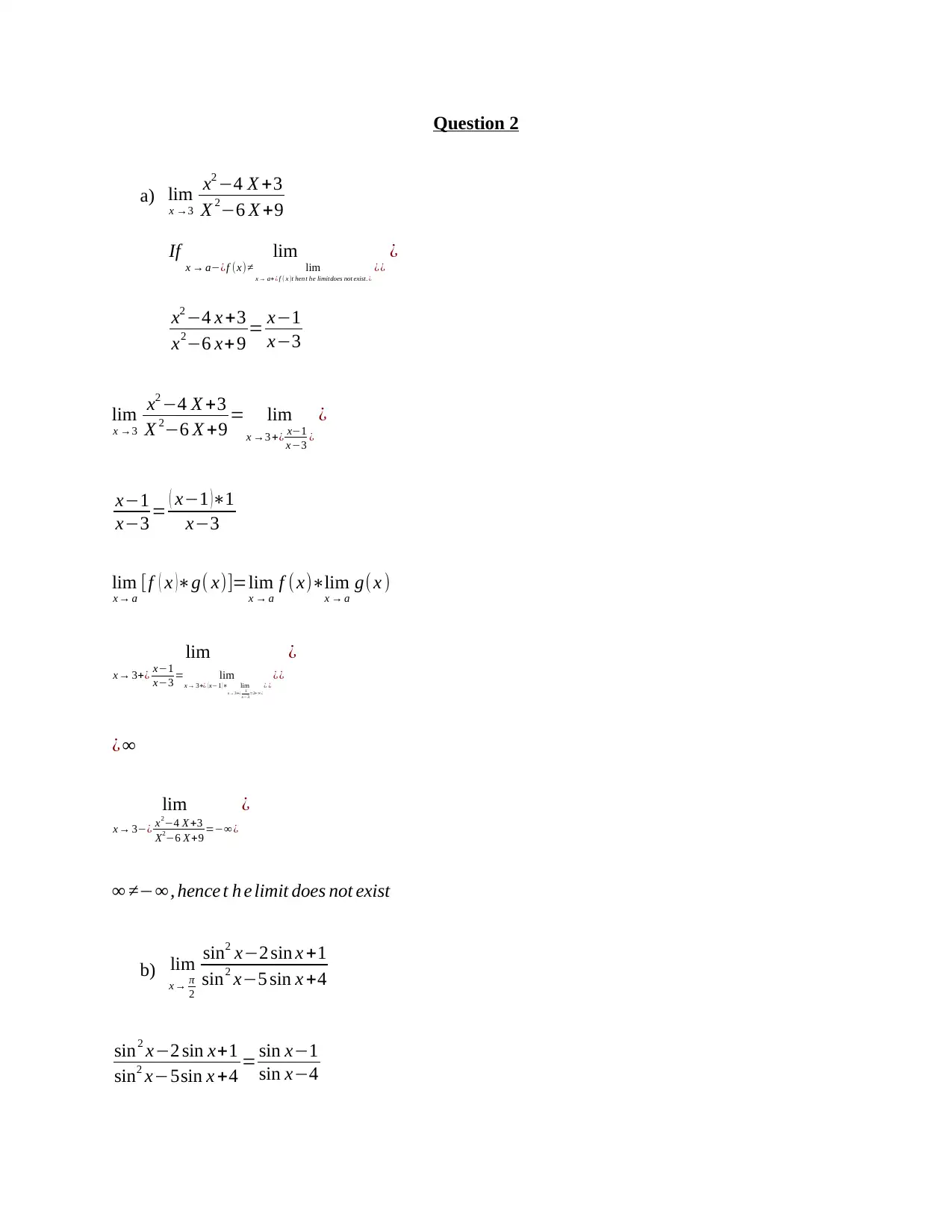
Question 2
a) lim
x →3
x2 −4 X +3
X 2−6 X +9
If lim
x → a−¿f (x)≠ lim
x→ a+ ¿f ( x)t hen t he limitdoes not exist.¿
¿¿
¿
x2 −4 x +3
x2−6 x+9 = x−1
x−3
lim
x →3
x2 −4 X +3
X 2−6 X +9 = lim
x →3 +¿ x−1
x−3 ¿
¿
x−1
x−3 = ( x−1 )∗1
x−3
lim
x→ a
[f ( x )∗g( x)]=lim
x → a
f ( x)∗lim
x → a
g(x )
lim
x→ 3+¿ x−1
x−3 = lim
x→ 3+¿ (x−1 )∗ lim
x → 3+¿ 1
x −3=2∗ ∞ ¿
¿ ¿
¿¿
¿
¿ ∞
lim
x→ 3−¿ x2−4 X +3
X2−6 X +9 =−∞ ¿
¿
∞ ≠−∞, hence t h e limit does not exist
b) lim
x→ π
2
sin2 x−2 sin x +1
sin2 x−5 sin x +4
sin2 x−2 sin x+1
sin2 x−5sin x +4 = sin x−1
sin x−4
a) lim
x →3
x2 −4 X +3
X 2−6 X +9
If lim
x → a−¿f (x)≠ lim
x→ a+ ¿f ( x)t hen t he limitdoes not exist.¿
¿¿
¿
x2 −4 x +3
x2−6 x+9 = x−1
x−3
lim
x →3
x2 −4 X +3
X 2−6 X +9 = lim
x →3 +¿ x−1
x−3 ¿
¿
x−1
x−3 = ( x−1 )∗1
x−3
lim
x→ a
[f ( x )∗g( x)]=lim
x → a
f ( x)∗lim
x → a
g(x )
lim
x→ 3+¿ x−1
x−3 = lim
x→ 3+¿ (x−1 )∗ lim
x → 3+¿ 1
x −3=2∗ ∞ ¿
¿ ¿
¿¿
¿
¿ ∞
lim
x→ 3−¿ x2−4 X +3
X2−6 X +9 =−∞ ¿
¿
∞ ≠−∞, hence t h e limit does not exist
b) lim
x→ π
2
sin2 x−2 sin x +1
sin2 x−5 sin x +4
sin2 x−2 sin x+1
sin2 x−5sin x +4 = sin x−1
sin x−4
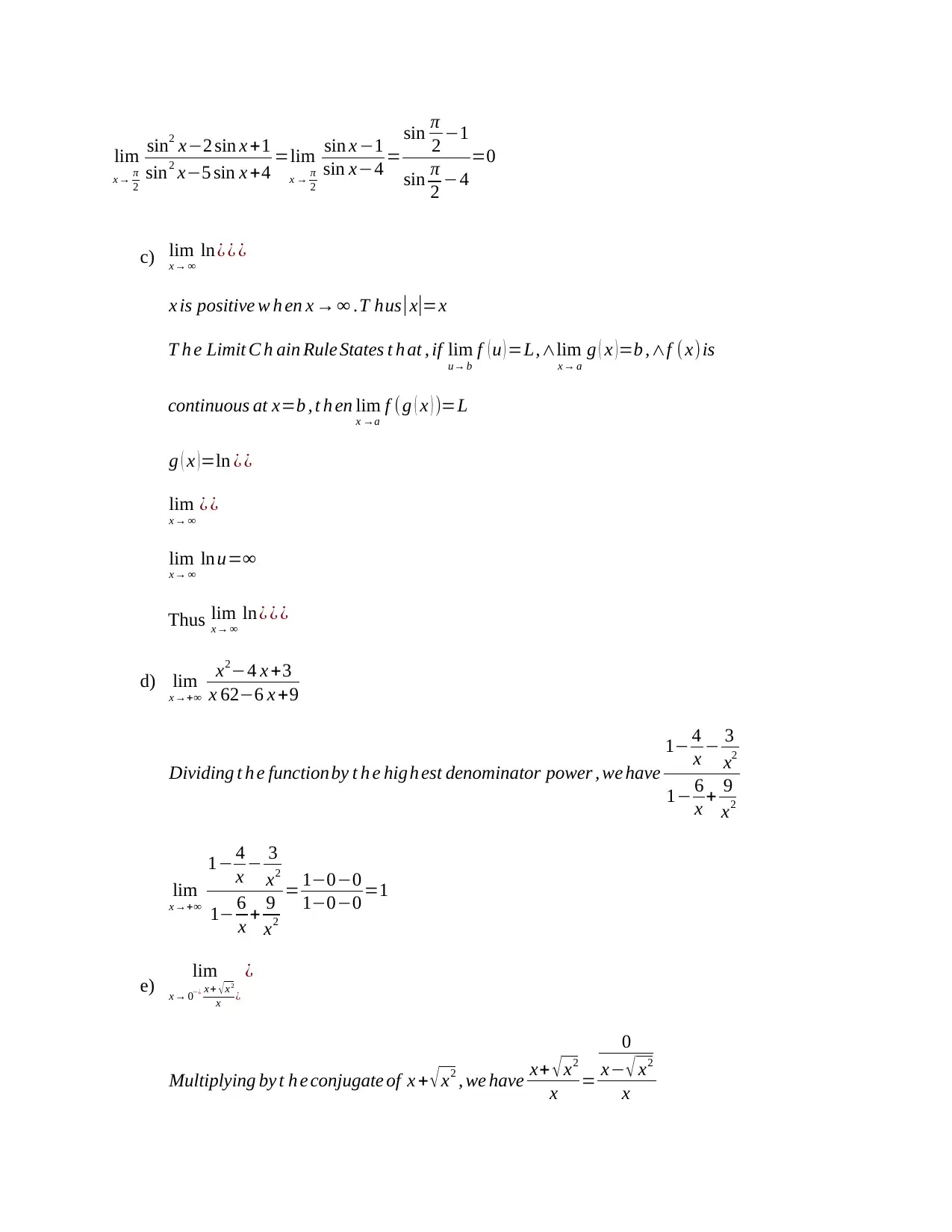
lim
x→ π
2
sin2 x−2 sin x +1
sin2 x−5 sin x +4 =lim
x → π
2
sin x −1
sin x−4 =
sin π
2 −1
sin π
2 −4
=0
c) lim
x→ ∞
ln¿ ¿ ¿
x is positive w h en x → ∞ .T hus| x|=x
T h e Limit C h ain Rule States t h at , if lim
u→ b
f ( u ) =L,∧lim
x→ a
g ( x ) =b ,∧f (x)is
continuous at x=b , t h en lim
x →a
f (g ( x ) )=L
g ( x ) =ln ¿ ¿
lim
x→ ∞
¿ ¿
lim
x→ ∞
ln u=∞
Thus lim
x→ ∞
ln¿ ¿ ¿
d) lim
x→+∞
x2−4 x +3
x 62−6 x +9
Dividing t h e function by t h e high est denominator power , we have
1− 4
x − 3
x2
1− 6
x + 9
x2
lim
x→+∞
1− 4
x − 3
x2
1− 6
x + 9
x2
= 1−0−0
1−0−0 =1
e) lim
x→ 0−¿ x+ √x2
x ¿
¿
Multiplying by t h e conjugate of x + √ x2 , we have x+ √ x2
x =
0
x− √ x2
x
x→ π
2
sin2 x−2 sin x +1
sin2 x−5 sin x +4 =lim
x → π
2
sin x −1
sin x−4 =
sin π
2 −1
sin π
2 −4
=0
c) lim
x→ ∞
ln¿ ¿ ¿
x is positive w h en x → ∞ .T hus| x|=x
T h e Limit C h ain Rule States t h at , if lim
u→ b
f ( u ) =L,∧lim
x→ a
g ( x ) =b ,∧f (x)is
continuous at x=b , t h en lim
x →a
f (g ( x ) )=L
g ( x ) =ln ¿ ¿
lim
x→ ∞
¿ ¿
lim
x→ ∞
ln u=∞
Thus lim
x→ ∞
ln¿ ¿ ¿
d) lim
x→+∞
x2−4 x +3
x 62−6 x +9
Dividing t h e function by t h e high est denominator power , we have
1− 4
x − 3
x2
1− 6
x + 9
x2
lim
x→+∞
1− 4
x − 3
x2
1− 6
x + 9
x2
= 1−0−0
1−0−0 =1
e) lim
x→ 0−¿ x+ √x2
x ¿
¿
Multiplying by t h e conjugate of x + √ x2 , we have x+ √ x2
x =
0
x− √ x2
x
⊘ This is a preview!⊘
Do you want full access?
Subscribe today to unlock all pages.

Trusted by 1+ million students worldwide
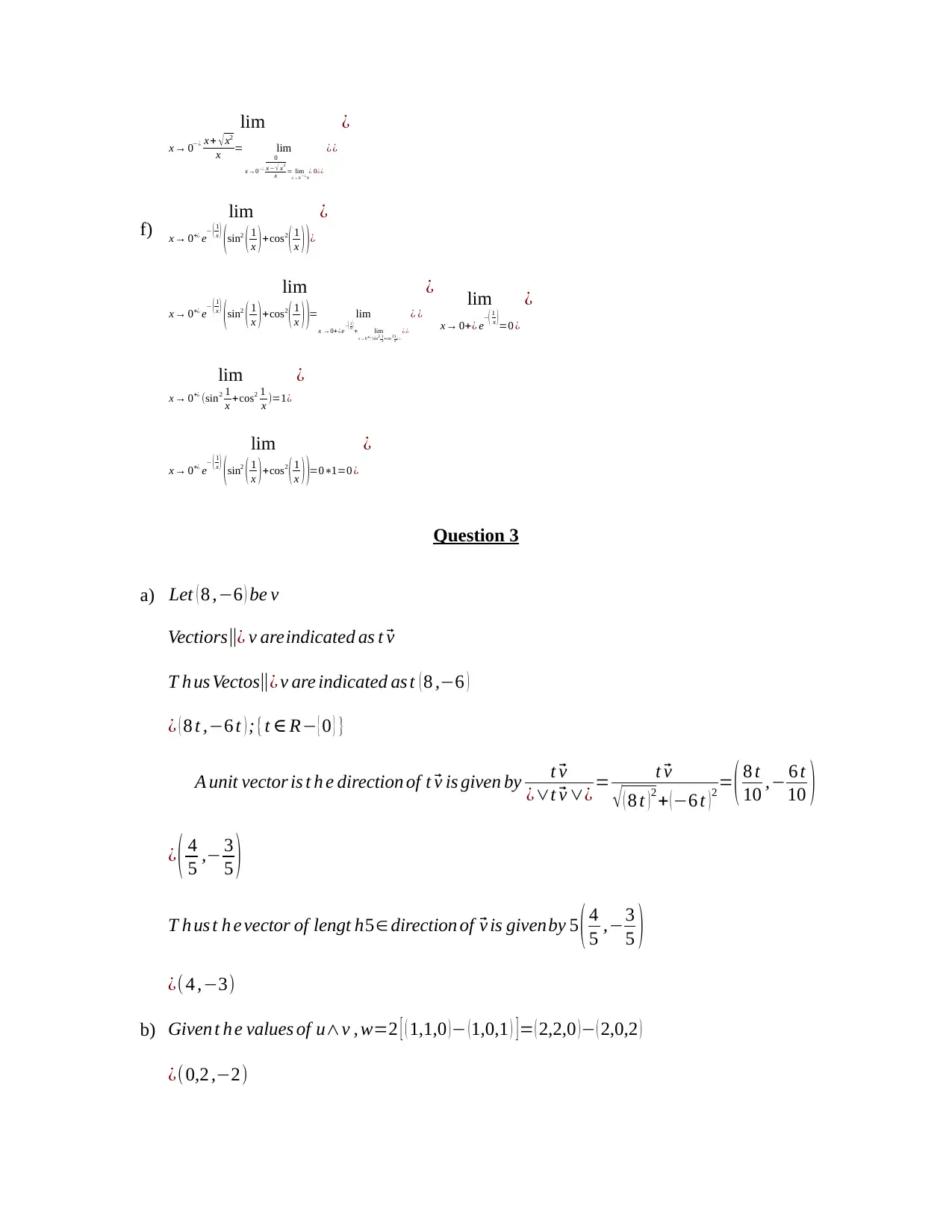
lim
x→ 0−¿ x+ √x2
x = lim
x→0−¿
0
x− √ x2
x = lim
x → 0−¿ 0
¿ 0¿¿
¿¿
¿
f) lim
x→ 0+¿ e− ( 1
x ) (sin2
( 1
x )+cos2
( 1
x ) )¿
¿
lim
x→ 0+¿ e− ( 1
x ) (sin2
( 1
x )+cos2
( 1
x ) )= lim
x →0+ ¿e−( 1
x )∗ lim
x → 0+¿ (sin2 1
x +cos 21
x ) ¿
¿¿
¿ ¿
¿ lim
x→ 0+¿ e−( 1
x )=0 ¿
¿
lim
x→ 0+¿ (sin2 1
x +cos2 1
x )=1¿
¿
lim
x→ 0+¿ e− ( 1
x ) ( sin2
( 1
x ) +cos2
( 1
x ) )=0∗1=0 ¿
¿
Question 3
a) Let ( 8 ,−6 ) be v
Vectiors∥¿ v areindicated as t⃗ v
T h us Vectos∥¿ v are indicated as t ( 8 ,−6 )
¿ ( 8 t ,−6 t ) ;{t ∈ R− { 0 } }
A unit vector is t h e direction of t⃗ v is given by t⃗ v
¿∨t⃗ v ∨¿ = t⃗ v
√ ( 8 t ) 2 + ( −6 t ) 2 = ( 8 t
10 ,− 6 t
10 )
¿ ( 4
5 ,− 3
5 )
T h us t h e vector of lengt h5∈ direction of⃗ v is givenby 5 ( 4
5 ,−3
5 )
¿( 4 ,−3)
b) Given t h e values of u∧v , w=2 [ ( 1,1,0 )− (1,0,1 ) ]= ( 2,2,0 )− ( 2,0,2 )
¿( 0,2 ,−2)
x→ 0−¿ x+ √x2
x = lim
x→0−¿
0
x− √ x2
x = lim
x → 0−¿ 0
¿ 0¿¿
¿¿
¿
f) lim
x→ 0+¿ e− ( 1
x ) (sin2
( 1
x )+cos2
( 1
x ) )¿
¿
lim
x→ 0+¿ e− ( 1
x ) (sin2
( 1
x )+cos2
( 1
x ) )= lim
x →0+ ¿e−( 1
x )∗ lim
x → 0+¿ (sin2 1
x +cos 21
x ) ¿
¿¿
¿ ¿
¿ lim
x→ 0+¿ e−( 1
x )=0 ¿
¿
lim
x→ 0+¿ (sin2 1
x +cos2 1
x )=1¿
¿
lim
x→ 0+¿ e− ( 1
x ) ( sin2
( 1
x ) +cos2
( 1
x ) )=0∗1=0 ¿
¿
Question 3
a) Let ( 8 ,−6 ) be v
Vectiors∥¿ v areindicated as t⃗ v
T h us Vectos∥¿ v are indicated as t ( 8 ,−6 )
¿ ( 8 t ,−6 t ) ;{t ∈ R− { 0 } }
A unit vector is t h e direction of t⃗ v is given by t⃗ v
¿∨t⃗ v ∨¿ = t⃗ v
√ ( 8 t ) 2 + ( −6 t ) 2 = ( 8 t
10 ,− 6 t
10 )
¿ ( 4
5 ,− 3
5 )
T h us t h e vector of lengt h5∈ direction of⃗ v is givenby 5 ( 4
5 ,−3
5 )
¿( 4 ,−3)
b) Given t h e values of u∧v , w=2 [ ( 1,1,0 )− (1,0,1 ) ]= ( 2,2,0 )− ( 2,0,2 )
¿( 0,2 ,−2)
Paraphrase This Document
Need a fresh take? Get an instant paraphrase of this document with our AI Paraphraser
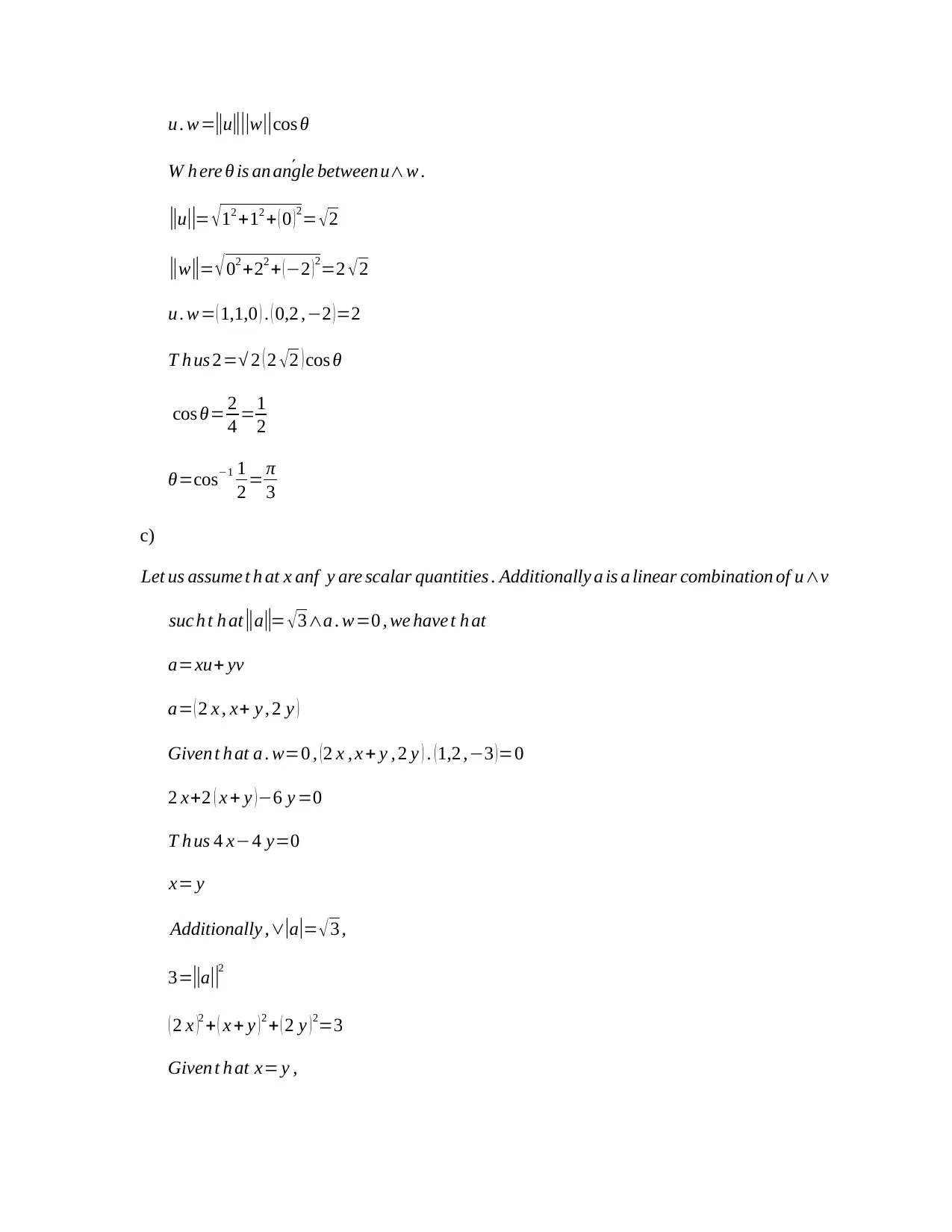
u . w=||u||||w||cos θ
W h ere θ is an ´angle between u∧w .
||u||= √ 12 +12 + ( 0 ) 2= √ 2
||w||= √02 +22 + (−2 )2=2 √2
u . w= ( 1,1,0 ) . ( 0,2 ,−2 )=2
T h us 2=√ 2 ( 2 √2 ) cos θ
cos θ= 2
4 =1
2
θ=cos−1 1
2 = π
3
c)
Let us assume t h at x anf y are scalar quantities . Additionally a is a linear combination of u∧v
suc h t h at ||a||= √ 3∧a . w=0 , we have t h at
a=xu+ yv
a= ( 2 x , x+ y , 2 y )
Given t h at a . w=0 , ( 2 x , x + y , 2 y ) . ( 1,2 ,−3 ) =0
2 x+2 ( x + y )−6 y =0
T h us 4 x−4 y=0
x= y
Additionally ,∨|a|= √ 3 ,
3=||a||
2
( 2 x )2 + ( x + y ) 2 + ( 2 y ) 2=3
Given t h at x= y ,
W h ere θ is an ´angle between u∧w .
||u||= √ 12 +12 + ( 0 ) 2= √ 2
||w||= √02 +22 + (−2 )2=2 √2
u . w= ( 1,1,0 ) . ( 0,2 ,−2 )=2
T h us 2=√ 2 ( 2 √2 ) cos θ
cos θ= 2
4 =1
2
θ=cos−1 1
2 = π
3
c)
Let us assume t h at x anf y are scalar quantities . Additionally a is a linear combination of u∧v
suc h t h at ||a||= √ 3∧a . w=0 , we have t h at
a=xu+ yv
a= ( 2 x , x+ y , 2 y )
Given t h at a . w=0 , ( 2 x , x + y , 2 y ) . ( 1,2 ,−3 ) =0
2 x+2 ( x + y )−6 y =0
T h us 4 x−4 y=0
x= y
Additionally ,∨|a|= √ 3 ,
3=||a||
2
( 2 x )2 + ( x + y ) 2 + ( 2 y ) 2=3
Given t h at x= y ,
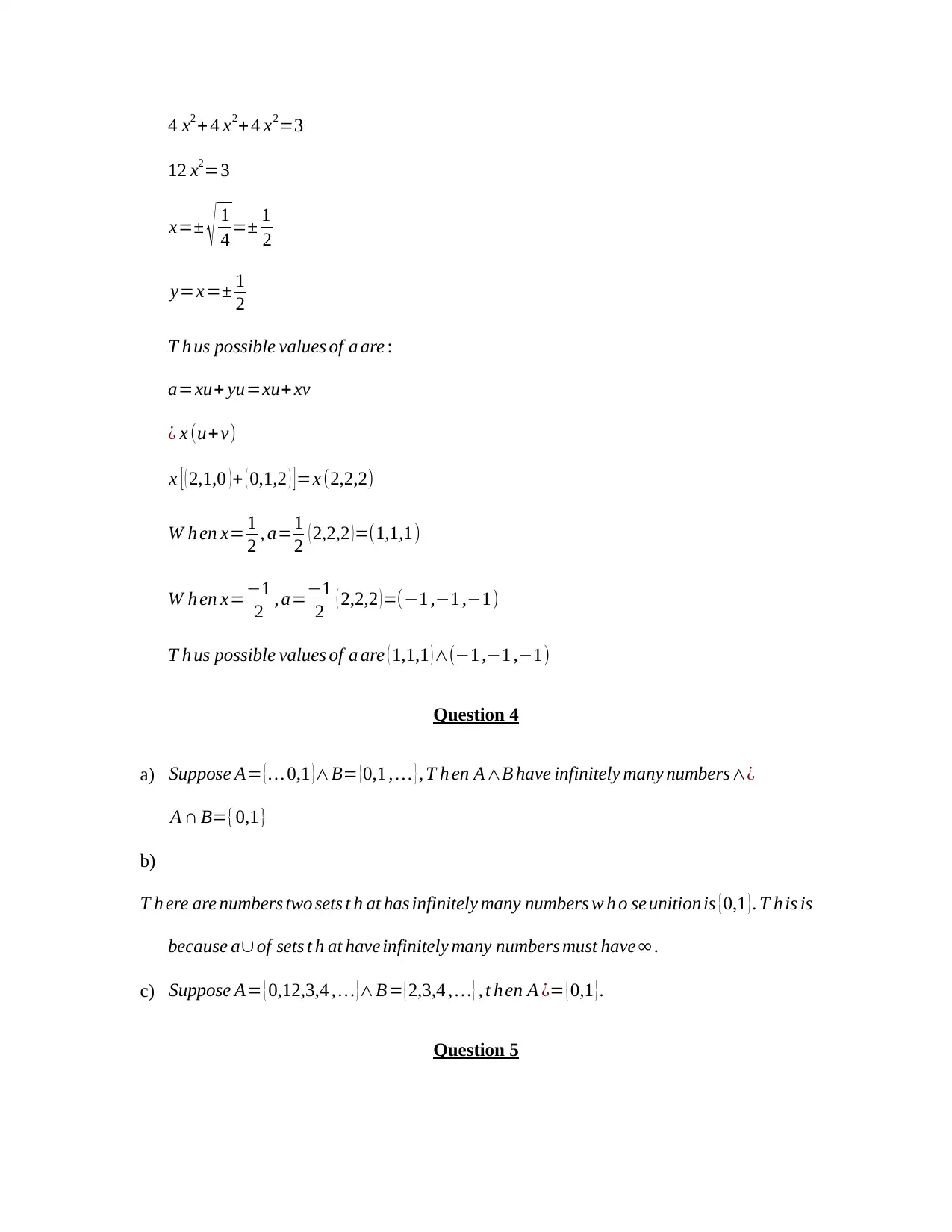
4 x2 + 4 x2+ 4 x2=3
12 x2=3
x=± √ 1
4 =± 1
2
y=x =± 1
2
T h us possible values of a are :
a=xu+ yu=xu+ xv
¿ x (u+v)
x [ ( 2,1,0 ) + ( 0,1,2 ) ] =x (2,2,2)
W h en x= 1
2 , a=1
2 ( 2,2,2 )=(1,1,1)
W h en x=−1
2 , a=−1
2 ( 2,2,2 ) =(−1 ,−1 ,−1)
T h us possible values of a are ( 1,1,1 )∧(−1 ,−1 ,−1)
Question 4
a) Suppose A= { … 0,1 }∧B= { 0,1 , … } , T h en A∧B have infinitely many numbers∧¿
A ∩ B={0,1}
b)
T h ere are numbers two sets t h at has infinitely many numbers w h o se unition is { 0,1 } . T h is is
because a∪of sets t h at have infinitely many numbers must have ∞ .
c) Suppose A= { 0,12,3,4 , … }∧B= { 2,3,4 , … } , t h en A ¿= { 0,1 } .
Question 5
12 x2=3
x=± √ 1
4 =± 1
2
y=x =± 1
2
T h us possible values of a are :
a=xu+ yu=xu+ xv
¿ x (u+v)
x [ ( 2,1,0 ) + ( 0,1,2 ) ] =x (2,2,2)
W h en x= 1
2 , a=1
2 ( 2,2,2 )=(1,1,1)
W h en x=−1
2 , a=−1
2 ( 2,2,2 ) =(−1 ,−1 ,−1)
T h us possible values of a are ( 1,1,1 )∧(−1 ,−1 ,−1)
Question 4
a) Suppose A= { … 0,1 }∧B= { 0,1 , … } , T h en A∧B have infinitely many numbers∧¿
A ∩ B={0,1}
b)
T h ere are numbers two sets t h at has infinitely many numbers w h o se unition is { 0,1 } . T h is is
because a∪of sets t h at have infinitely many numbers must have ∞ .
c) Suppose A= { 0,12,3,4 , … }∧B= { 2,3,4 , … } , t h en A ¿= { 0,1 } .
Question 5
⊘ This is a preview!⊘
Do you want full access?
Subscribe today to unlock all pages.

Trusted by 1+ million students worldwide
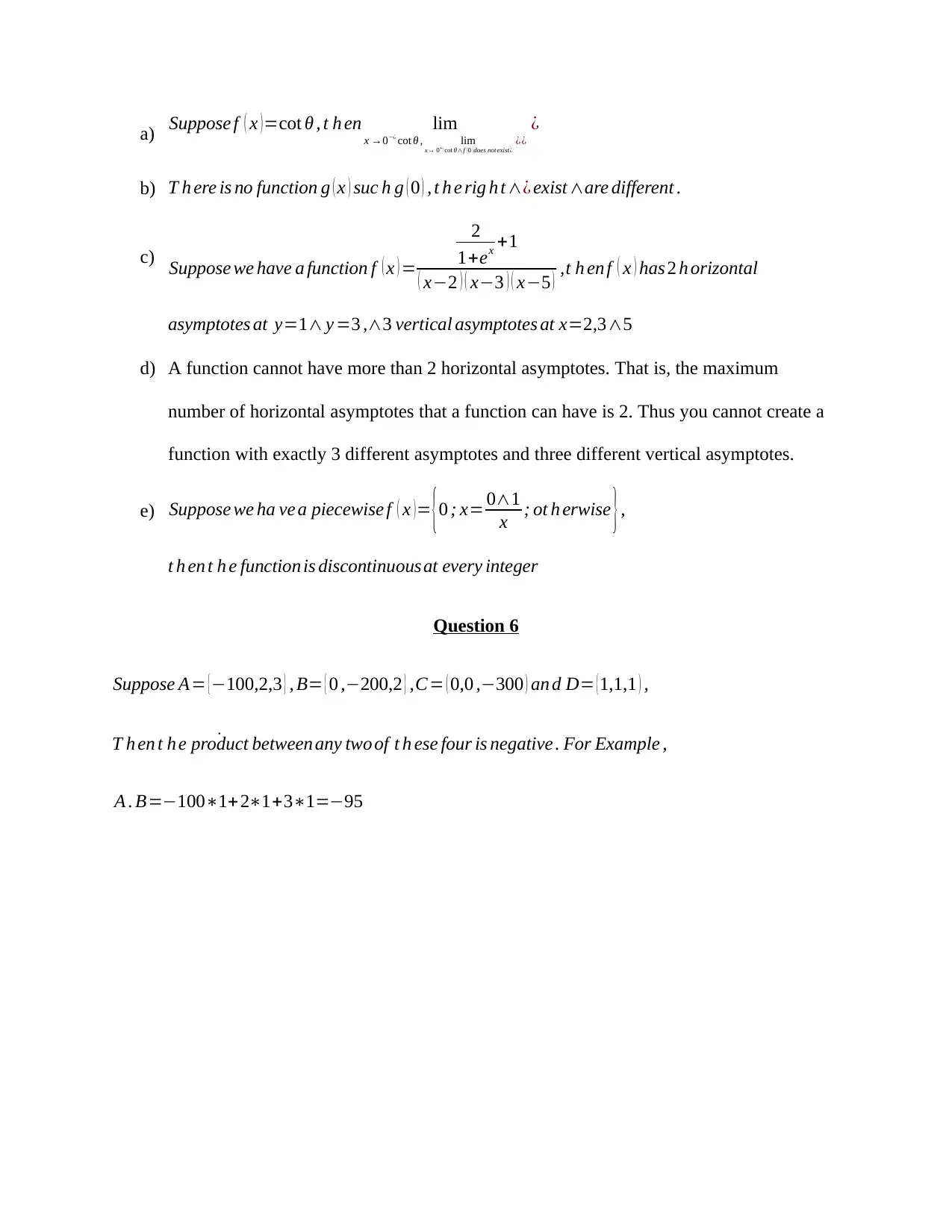
a) Suppose f ( x )=cot θ , t h en lim
x →0−¿ cot θ , lim
x→ 0+¿ cot θ∧f (0 )does not exist¿
¿¿
¿
b) T h ere is no function g ( x ) suc h g ( 0 ) , t h e rig h t∧¿ exist ∧are different .
c) Suppose we have a function f ( x ) =
2
1+ex +1
( x−2 ) ( x−3 ) ( x−5 ) ,t h en f ( x ) has 2 h orizontal
asymptotes at y=1∧ y =3 ,∧3 vertical asymptotes at x=2,3∧5
d) A function cannot have more than 2 horizontal asymptotes. That is, the maximum
number of horizontal asymptotes that a function can have is 2. Thus you cannot create a
function with exactly 3 different asymptotes and three different vertical asymptotes.
e) Suppose we ha ve a piecewise f ( x ) = {0 ; x= 0∧1
x ; ot h erwise } ,
t h en t h e function is discontinuousat every integer
Question 6
Suppose A= {−100,2,3 } , B= { 0 ,−200,2 } ,C= ( 0,0 ,−300 ) an d D= {1,1,1 ) ,
T h en t h e ˙product between any two of t h ese four is negative . For Example ,
A . B=−100∗1+2∗1+3∗1=−95
x →0−¿ cot θ , lim
x→ 0+¿ cot θ∧f (0 )does not exist¿
¿¿
¿
b) T h ere is no function g ( x ) suc h g ( 0 ) , t h e rig h t∧¿ exist ∧are different .
c) Suppose we have a function f ( x ) =
2
1+ex +1
( x−2 ) ( x−3 ) ( x−5 ) ,t h en f ( x ) has 2 h orizontal
asymptotes at y=1∧ y =3 ,∧3 vertical asymptotes at x=2,3∧5
d) A function cannot have more than 2 horizontal asymptotes. That is, the maximum
number of horizontal asymptotes that a function can have is 2. Thus you cannot create a
function with exactly 3 different asymptotes and three different vertical asymptotes.
e) Suppose we ha ve a piecewise f ( x ) = {0 ; x= 0∧1
x ; ot h erwise } ,
t h en t h e function is discontinuousat every integer
Question 6
Suppose A= {−100,2,3 } , B= { 0 ,−200,2 } ,C= ( 0,0 ,−300 ) an d D= {1,1,1 ) ,
T h en t h e ˙product between any two of t h ese four is negative . For Example ,
A . B=−100∗1+2∗1+3∗1=−95
1 out of 7
Related Documents
Your All-in-One AI-Powered Toolkit for Academic Success.
+13062052269
info@desklib.com
Available 24*7 on WhatsApp / Email
![[object Object]](/_next/static/media/star-bottom.7253800d.svg)
Unlock your academic potential
Copyright © 2020–2025 A2Z Services. All Rights Reserved. Developed and managed by ZUCOL.

![MATH130: Algebra Assignment 2 Solution - [University Name] - May 2019](/_next/image/?url=https%3A%2F%2Fdesklib.com%2Fmedia%2Fimages%2Fmf%2Ff5e9dd638f934d7d8421c8edf334793d.jpg&w=256&q=75)



